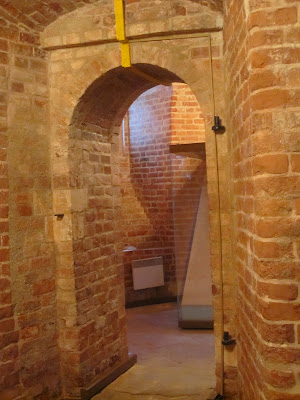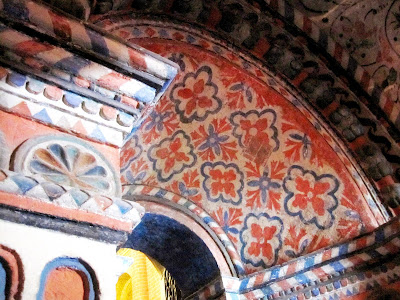As a youth, I recall seeing a picture of St. Basil's Cathedral and its amazing multi-colored onion domes, and associating it with the Kremlin, which at that time was the headquarters of the evil Soviet Empire that threatened the world with nuclear destruction.
It was a place so foreign, so powerful, so opaque to outside view, that I never imagined I would see it during my lifetime. Now, I consider the visit to St. Basil's (and Red Square, of which it is a part, and the Kremlin, next to it), the highlight of my travel experiences, particularly because the visit supplanted the views of my early youth with both an unexpected feeling of freedom and an unanticipated beauty.
I am finding variations and inconsistencies in the stated origins of St. Basil's (which appears to lay largely in legend), and the timeline for its construction, so I will attempt to piece together a version of it. The original church on this spot was known as Trinity Church, built of white stone, from 1366 to 1368. Jump forward nearly two hundred years to Ivan the Terrible, who ruled from 1533 until 1584, the first ruler to be crowned Tsar of all Russia, was involved in the Astrakhan campaign (in the area of the Volga River and the Caspian Sea) of the Russo-Kazan War. Each time the Russians had a victory in battle, Ivan had a small wooden memorial church built next to the walls of Trinity. Prior to the culminating battle, there were seven wooden chapels surrounding Trinity Church. On October 1, 1552, the day of the Feast of Intercession of the Virgin, the Russians, in the culminating battle of the war, captured the capital city of Kazan. The Feast of Intercession of the Virgin is a holy day in the Eastern Orthodox Church which commemorates what appears to be a number of events based on a central theme. One version of the theme is that in the tenth century in Constantinople, the Virgin Mary entered a church through the dome and knelt and prayed for all faithful Christians. She asked her Son, Jesus Christ, to accept the prayers of all people entreating him and looking to her for protection (the intercession). Afterwards she spread her veil over all the people in the church as a protection for them. Because of the connection of this feast day with the culminating victory over Kazan, Ivan commissioned one more church to be built next to Trinity which he called the Church of the Intercession of the Virgin by the Moat (a moat ran right next to this new addition). About a year later, Ivan ordered that the stone Trinity Church and eight wooden churches surrounding it be demolished, and a new cathedral built to replace it, to commemorate his war campaigns. The new church kept the same basic structure, with one central chapel surrounded by eight other chapels.
Construction started in 1555 and continued to 1560. The foundations were built of white stone and the chapels were build of red brick. All nine chapels are identifiable from the outside by a roof ornament. The largest chapel, the one in the center, is dedicated to the Intercession of Mary, and it is beneath the tall, tent-roofed spire.
 |
| Intercession of Mary |
 |
| Inside tent-roofed spire |
It commemorates the final assault of Kazan on October 1, 1552. It has a 16th century iconostasis within it
and while we were there, a group of singers sang some beautiful music a capella that we recorded on a camera. Four of the chapels, octagonal in shape, are beneath the largest onion domes which are placed at the four major compass points. The north chapel, dedicated to Saints Cyprian, Justinia, Adrian and Natalia of Nicomedia, is covered by a green and yellow ribbed dome.
 |
| North chapel |
The south chapel, dedicated to Saint Nicholas, is covered by a dome with red and green squares,
 |
| South chapel |
with pyramid shapes of the same color protruding from them.
The east chapel, dedicated to the Holy Trinity, is covered by a dome with rounded light-blue and pointed white ribs.
 |
| East chapel |
The west chapel, dedicated to the entry of Christ into Jerusalem, is covered by a dome with alternating red and white zigzag lines.
 |
| West chapel |
Four of the chapels, cuboid in shape, although it is now difficult to determine the shape because of later additions, are beneath smaller onion domes in-between the major compass points. The northwest chapel, dedicated to St. Gregory the Illuminator of Armenia, is covered by a dome with alternating green and yellow curvy flat ribs.
 |
| Northwest chapel |
The northeast chapel, dedicated to the three patriarchs of Alexandria, is covered by a dome with flat over-lapping diamond shaped pieces, arranged in angled dark red and dark green rows.
 |
| Northeast chapel |
The southeast chapel, dedicated to St. Alexander Svirsky, is covered by a dome with green flat lines, arranged in diamond shapes, with yellow centers of protruding pyramid shapes.
 |
| Southeast chapel |
The southwest chapel, dedicated to St. Barlaam of Khutyn, is covered by a dome with flat green triangles alternating with protruding yellow pyramids.
 |
| Southwest chapel |
A tenth chapel, capped by another small onion dome, now with a flat green background, interspersed by rounded yellow ribs and a vertical line of protruding red pyramids,
 |
| Chapel of Basil the Blessed |
was added 28 years later, in 1588. It is over the grave of Basil the Blessed or Basil the fool for Christ (a term derived from the writings of Paul, for those using unconventional behavior to challenge social norms)
to commemorate his canonization. Basil was an apprentice shoemaker in Moscow who started shoplifting to give the stolen goods to the poor. He went naked and weighed himself down with chains. He rebuked Ivan the Terrible for not paying attention to the church and predicted that Ivan would be damned. Basil died while Kazan was under siege, in 1552, and was buried next to the stone wall of the old Trinity Church. Ivan the Terrible was one of the pallbearers at his funeral. Another chapel was added in 1672 to the southeast, dedicated to St. John the Blessed of Moscow. St. Basil's is shaped like a bonfire, with each chapel of varying height, capped with a pointed onion dome, representing a separate flame.
It had no antecedent in Russian architecture. Inside, St. Basil's is a labyrinth of narrow corridors
and cylinders representing the various chapels.
It was very dark, and flash photography was not allowed, so good inside pictures were hard to come by. The original domes were colored white, red and gold, with some moderate use of green and blue insertions. The more outlandish and vibrant current coloration developed in stages after the 1680s. A bell tower was also added.
 |
| bell tower |
From 1772 to 1784 the cathedral got a metal roof, was white-washed and the domes were gold-leafed. Then it barely survived Napoleon. He ordered it destroyed in 1812, but his troops did not have time to do so before they were forced to leave. In 1817 the church was changed back to its colorful appearance, houses that surrounded it were removed and the nearby moat was covered. In front of the church is a statue of a butcher and a prince who, in 1612, raised and led an army that ejected Poles that were occupying the Kremlin.
In 1928, as part of the the Soviet Union's state atheism campaign, St. Basil's was confiscated from the Russian Orthodox Church and has been operated as a museum since. During the time of Stalin, he ordered St. Basil's demolished so that it would not be in the way of parades on Red Square. The architect Pyotr Baranovsky refused to prepare it for demolition. He saved the building, but spent five years in prison for doing so. The church is now a museum. The covered stair case from the outside and inside:





























Fun to learn about each of the domes individually. This was certainly an incredible experience. I'd love to see it again.
ReplyDeleteAwesome pictures. I have always seen pictures of the domes but never before saw pictures of the inside.
ReplyDelete